How to create a learning course with iSpring
In this article we will learn how to create an e-Learning course item (SCO) with an iSpring authoring tool. Later, this course can be uploaded to a third-party LMS such as Moodle or Blackboard. With the iSpring authoring tool you can create a course in SCORM, AICC, Experience API, or a brand new cmi5 standard. Also in this guide we will delve deep into learning course settings that will be automatically transmitted to an LMS after you upload a course. Let’s learn about this process using the most sophisticated tool, iSpring Suite.
Publish a course with iSpring
To publish your course with iSpring:
- 1
Open your PowerPoint presentation project that you want to make into a course.
- 2
Click Publish on the iSpring panel.

- 3
Select the LMS tab on the left.
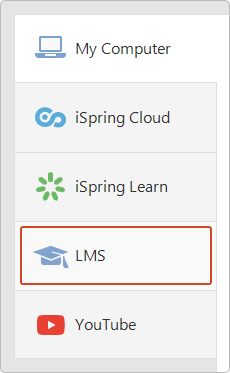
- 4
After these steps find the LMS profile section.
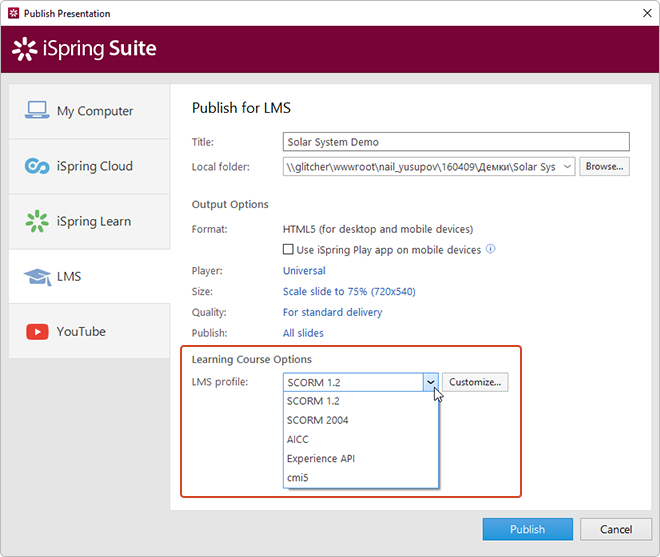
- 5
Select the standard that your LMS supports: SCORM 1.2, SCORM 2004, AICC, Experience API (or the previous Tin Can) or cmi5.
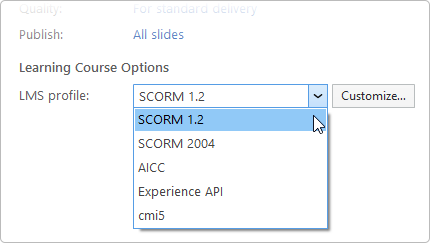
- 6
Adjust your course parameters.
- 7
Click Publish.
Hint: if you publish a selected range of slides and still want to include quizzes, make sure that you have selected slides with quizzes. Hold the Shift key to select a group of slides in the PowerPoint slide list. Hold the Ctrl key whenever you want to add any separate slide to your selection. To publish only the selected slides, click Publish on the iSpring Suite 9 ribbon and choose Selected slides in the Publish section.
A .zip archive will be created automatically after publishing a course in iSpring Suite 9. After that, a .zip package is ready for uploading to any LMS that supports this LMS profile.
Learning Course options
All course types have similar settings. All of them will be transmitted to your LMS automatically along with adding the iSpring course to your course list. Let’s see which parameters can be used with each course type, and have a look at their distinctive characteristics.
SCORM 1.2
Reports a single status to the LMS based on both presentation slide views and Quiz grades. Default status is Passed/Failed, but can be customized (for example, Complete/Incomplete, Complete/Failed and Passed/Incomplete).
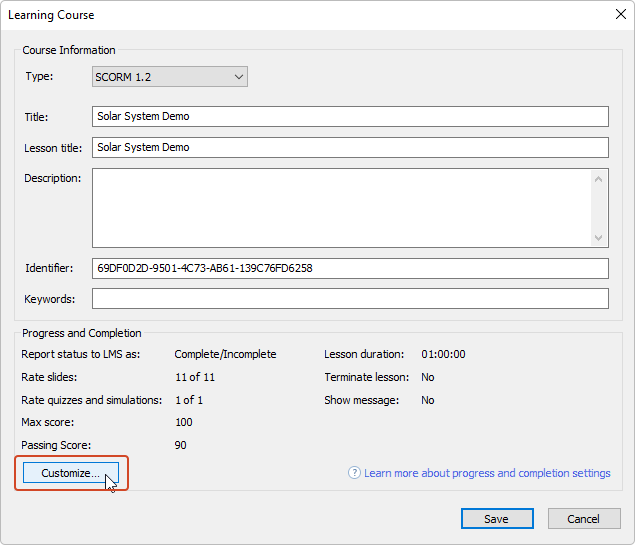
In addition, a new Identifier field was added to SCORM 1.2 which can be modified manually by users if necessary. To change the Progress and Completion settings click Customize.
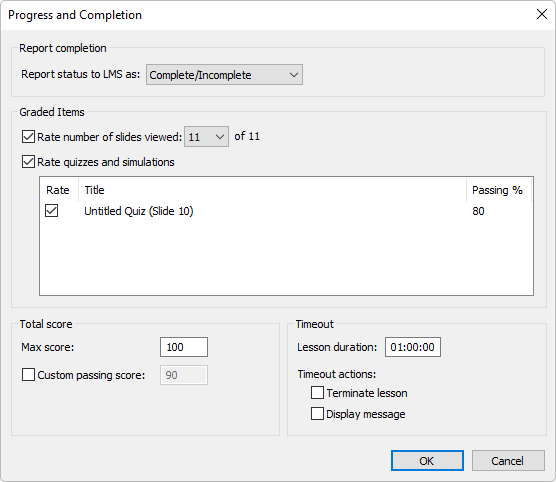
| Report Progress and Completion settings | |
| Rate number of slides viewed |
Choose a number of slides that must be viewed by a learner in order to complete the course. Note: Be careful with hidden slides. |
| Rate quizzes and simulations |
Select this checkbox to take the results of the listed quizzes and dialogue simulations into account in the final score. Don’t forget to check quizzes that you want to rate. By default, weight of each quiz and dialogue simulation is 1 and can’t be changed in iSrping Suite 9. |
| Max Score |
Specify the maximum score a learner can get by viewing all slides and completing all quizzes. Recommended value is 100. |
| Custom passing score |
Specify the minimum number of points a learner should score to pass the course item. |
| Timeout actions |
Set an action in the event of a timeout. You can Terminate the lesson and/or Display a message that time has expired. Recommended value is 1:00:00 |
| Report status to LMS as |
Set a status (Passed/Failed, Complete/Incomplete, Complete/Failed and Passed/Incomplete) that will be shown in your LMS after the course has been completed by a learner. |
SCORM 2004
Has several editions: 2nd, 3rd, and 4th. Each of them has the same set of course properties. To change the Progress and Completion settings click Customize.
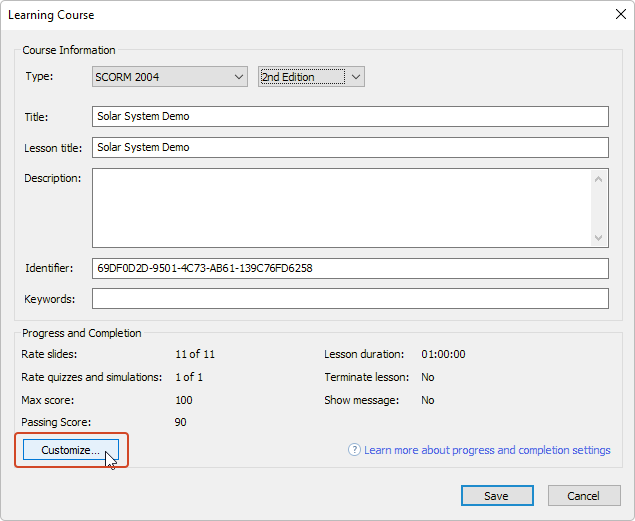
Reports both Slide progress and Quizzes as two different values and statuses: Complete/Incomplete for slide progress and Passed/Failed for quiz part.
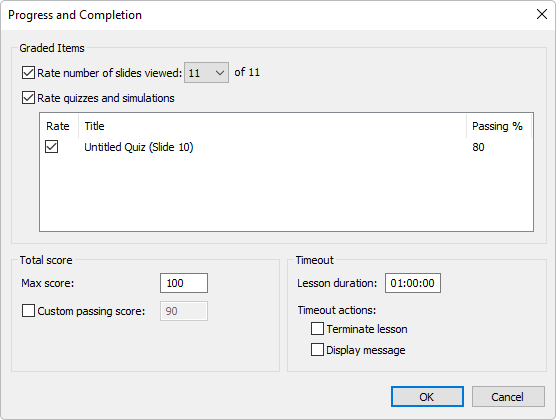
AICC
AICC (Aviation Industry Computer-Based Training Committee) is a worldwide association that develops computer technology-based training specifications in aviation. It shares almost the same settings as SCORM 1.2. Instead of a Lesson Title, it has an Identifier that is automatically assigned. The AICC standard is less popular than SCORM 1.2, but is still used in a number of learning systems.
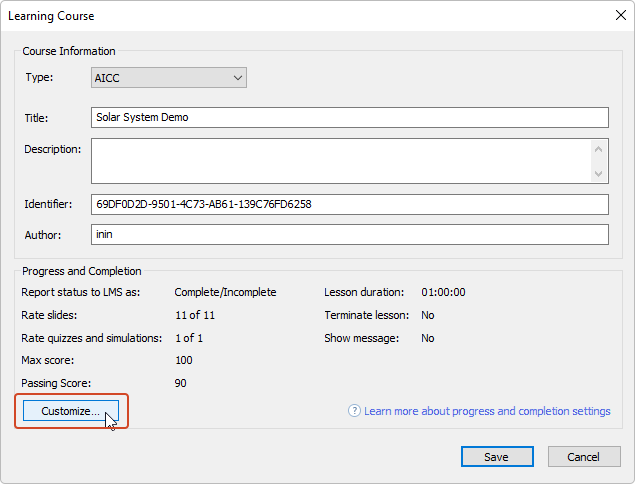
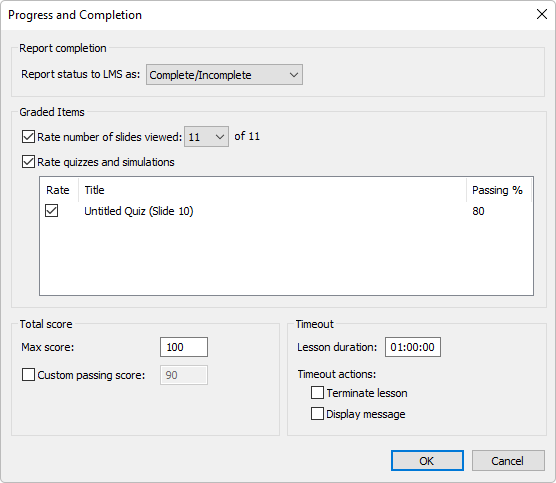
Experience API (aka Tin Can API)
Experience API has almost the same settings as SCORM 1.2., however, it is necessary to pay close attention to the main important functions:
- Instead of a Lesson Title, it has an Identifier that is automatically assigned.
- An additional field xAPI endpoint is added. Enter the URL of a specific LRS (Learning Record Score) server where the statistics transmitted to via the xAPI protocol will be stored. xAPI server can be a part of the LMS or an independent service for collecting and viewing the statistics.
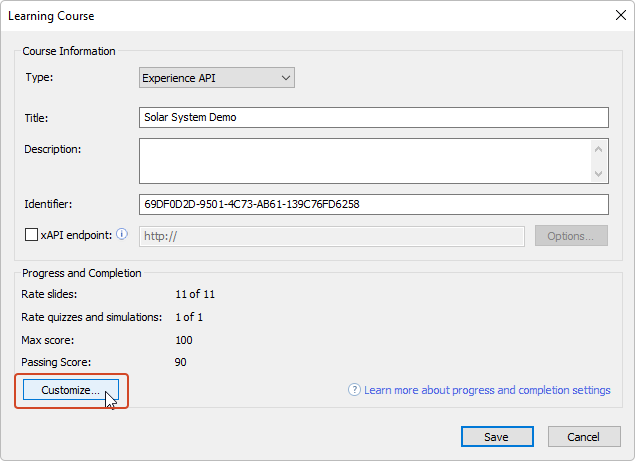
After specifying the xAPI server, click Options to enter your login and password to the statistics server. A learner information is usually left blank: it’s additionally requested when a course or a quiz is being viewed.
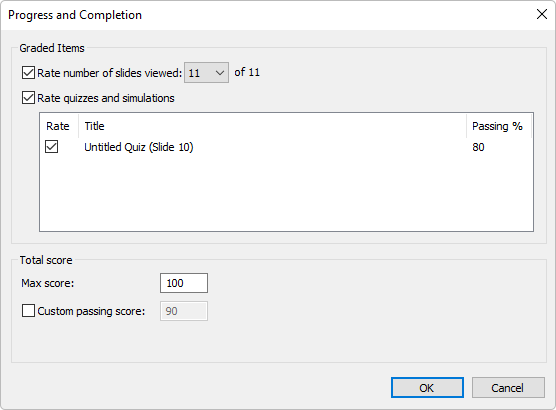
cmi5
Now it’s possible to publish courses to a brand new format called cmi5.
cmi5 is a new standard for learning management systems. This standard makes it possible to take a course both online and offline and supports additional data formats such as audio. Also, cmi5 is very convenient because the learning materials can be displayed in the same window as the LMS (without any pop-up windows as in SCORM) and the cmi5 specification takes only a couple of pages.
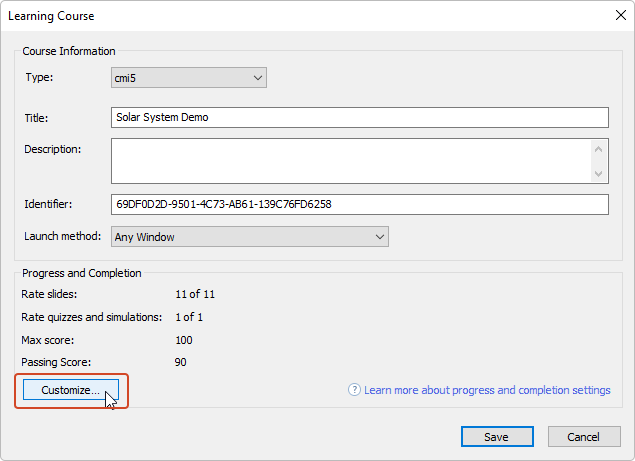
Before configuring the progress and completion settings, Launch method can be selected: Any window or Own window. To customize other data, click Customize.
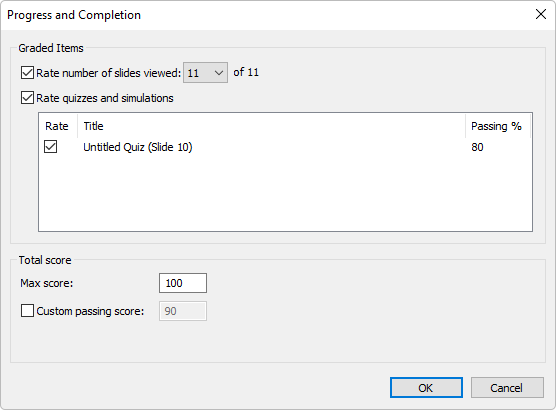
This was an overview of the customizable parameters which help to manage the statistical information transmitted to the LMS based on the results of training courses.
iSpring Learn LMS
The LMS Publishing option is good for third-party systems only, like Moodle or Blackboard. If you use iSpring Learn as your LMS along with an iSpring course authoring tool, select the respective tab in the Publish window on the left. This will publish and upload your course item into the system in one click. Read more in iSpring Learn HelpDocs →
But why not SCORM or Experience API? Technically, iSpring Learn follows the principles of Experience API communication but it's not the same. An iSpring learning course communicates with iSpring LMS on a very basic level and the system captures explicit information about the learning progress. Let's call it proprietary iSpring course communication API.
Benefits of using iSpring Learn LMS with an iSpring Authoring tool:
- Explicit learner experience information (e.g. number of seconds a learner has spent on each slide). Learn more about reports in iSpring Learn.
- Free mobile app that works even offline. Other systems don't provide such a convenience.
- Publish fr om the iSpring Authoring tool in one click.
- You can create a step-by-step learning path for each employee or department and set a strict completion order.
- Feel free to upload your video tutorials (FLV, MP4), Flash clips (SWF) and audio tracks (MP3, WAV), as well as supplementary documents (PDF, DOC, XLS, PPT).
- Extended tech support and fast problem resolution. If a third-party LMS is being used, your Help Desk tickets will depend on the other vendor as well. You can read more information about all the features by following this link.
Related Articles
